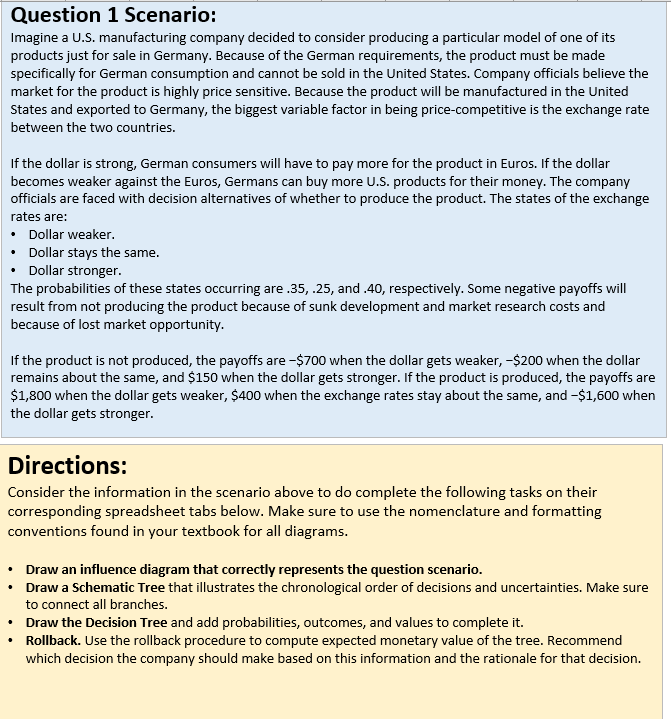
Question 1 Scenario: Imagine a U.S. manufacturing company decided to consider producing a particular model of one of its products just for sale in Germany. Because of the German requirements, the product must be made specifically for German consumption and cannot be sold in the United States. Company officials believe the market for the product is highly price sensitive. Because the product will be manufactured in the United States and exported to Germany, the biggest variable factor in being price-competitive is the exchange rate between the two countries. If the dollar is strong, German consumers will have to pay more for the product in Euros. If the dollar becomes weaker against the Euros, Germans can buy more U.S. products for their money. The company officials are faced with decision alternatives of whether to produce the product. The states of the exchange rates are: Dollar weaker. Dollar stays the same. Dollar stronger. The probabilities of these states occurring are.35, .25, and.40, respectively. Some negative payoffs will result from not producing the product because of sunk development and market research costs and because of lost market opportunity. If the product is not produced, the payoffs are -$700 when the dollar gets weaker, -$200 when the dollar remains about the same, and $150 when the dollar gets stronger. If the product is produced, the payoffs are $1,800 when the dollar gets weaker, $400 when the exchange rates stay about the same, and -$1,600 when the dollar gets stronger. Directions: Consider the information in the scenario above to do complete the following tasks on their corresponding spreadsheet tabs below. Make sure to use the nomenclature and formatting conventions found in your textbook for all diagrams. Draw an influence diagram that correctly represents the question scenario. Draw a Schematic Tree that illustrates the chronological order of decisions and uncertainties. Make sure to connect all branches. Draw the Decision Tree and add probabilities, outcomes, and values to complete it. Rollback. Use the rollback procedure to compute expected monetary value of the tree. Recommend which decision the company should make based on this information and the rationale for that decision. Question 1 Scenario: Imagine a U.S. manufacturing company decided to consider producing a particular model of one of its products just for sale in Germany. Because of the German requirements, the product must be made specifically for German consumption and cannot be sold in the United States. Company officials believe the market for the product is highly price sensitive. Because the product will be manufactured in the United States and exported to Germany, the biggest variable factor in being price-competitive is the exchange rate between the two countries. If the dollar is strong, German consumers will have to pay more for the product in Euros. If the dollar becomes weaker against the Euros, Germans can buy more U.S. products for their money. The company officials are faced with decision alternatives of whether to produce the product. The states of the exchange rates are: Dollar weaker. Dollar stays the same. Dollar stronger. The probabilities of these states occurring are.35, .25, and.40, respectively. Some negative payoffs will result from not producing the product because of sunk development and market research costs and because of lost market opportunity. If the product is not produced, the payoffs are -$700 when the dollar gets weaker, -$200 when the dollar remains about the same, and $150 when the dollar gets stronger. If the product is produced, the payoffs are $1,800 when the dollar gets weaker, $400 when the exchange rates stay about the same, and -$1,600 when the dollar gets stronger. Directions: Consider the information in the scenario above to do complete the following tasks on their corresponding spreadsheet tabs below. Make sure to use the nomenclature and formatting conventions found in your textbook for all diagrams. Draw an influence diagram that correctly represents the question scenario. Draw a Schematic Tree that illustrates the chronological order of decisions and uncertainties. Make sure to connect all branches. Draw the Decision Tree and add probabilities, outcomes, and values to complete it. Rollback. Use the rollback procedure to compute expected monetary value of the tree. Recommend which decision the company should make based on this information and the rationale for that decision







